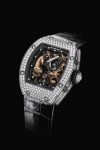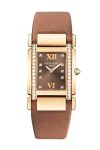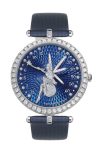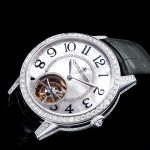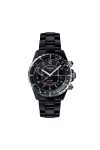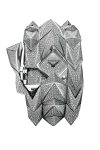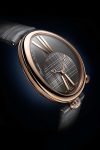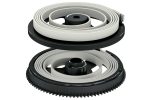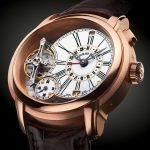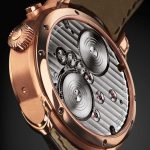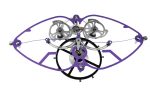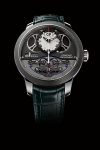Audemars Piguet
Time’s Up
Q: What makes a women’s watch?
Not a straightforward question, is it? Here, let’s look at it this way. What do you think of when someone says the words “women’s watches” to you? What timepiece comes to mind?
That’s not an easy thing to pin down either — because for every dainty Chopard Happy Diamonds watch, you have the formidable heft of a Richard Mille RM51-01 Tourbillon Tiger & Dragon. For every extravagantly voluptuous diamond-set Crash de Cartier, you have the classic symmetry of a Patek Philippe Twenty~4. For every wildly whimsical Van Cleef & Arpels Lady Arpels Féerie, you have the regal sophistication of a Breguet Queen of Naples. For every vibrantly hued Bulgari Serpenti with enameled scales, you have the monochrome Chanel J12 in inky ceramic. For every fiercely glamorous Audemars Piguet Diamond Fury, you have the unadorned, quietly utilitarian Baume & Mercier Promesse in stainless steel.
Confession time now — that was a trick question.
There is no definitive women’s watch, because there is no real definition of a women’s watch. If you follow this statement to its logical conclusion, you’ll realize that, really, there is no such thing as a women’s watch. (Fun activity — repeat the above exercise with men’s watches, and — guess what! There’s no such thing as a men’s watch either. Shocker.)
The truth is it’s easier for us to think about watches and make decisions about them when they’ve been conveniently compartmentalized for us in that way. Buying a watch for yourself or someone else and don’t know where to start? Great news! A pre-selected list already exists based on your chromosomal makeup. Never mind if a man might actually quite like the Jaeger-LeCoultre Rendez-Vous Tourbillon, or if his wife is pretty keen on the military-inflected Blancpain Fifty Fathoms dive watch.
Another revelation that’s going to surprise absolutely zero people here — the above examples are taken from real life. Women frequently wear men’s watches and there are men who wear women’s watches. So if that’s the case, what’s the objection to keeping the terminology? People eventually end up with what they really want anyway. People who already know something about watches, that is.
Instead of taking the categorical women’s watch/men’s watch approach, what if we were able to look at things along a feminine–masculine spectrum? Instead of an either/or conversation, what if we chose a more calibrated assessment? We no longer wear watches primarily as a functional object; we wear them to express our personalities. Especially in this day and age, applying the gender binary in this reductive way is just so basic I can’t even.
We couldn’t answer the question at the beginning of this conversation, but perhaps that’s because we just weren’t thinking about it the right way.
Q: What makes a women’s watch?
A: The woman wearing it.
It’s as simple as that; there is no other criteria needed. In other words, the first rule of the future of women’s watches is: You do not talk about women’s watches.
Now that’s settled, we can move on to the next question.
It has to look good. It has to be versatile. It has to be well made. It has to be something she can depend on. A one-word answer to this question would be: everything.
This is why we can spend entire geological ages in search of comfortable heels, because we straight up refuse to accept that looking good could get in the way of us getting stuff done. Why else is there this massive discrepancy in the percentage of men who wear mechanical watches and women who wear mechanical watches? Because quartz watches don’t get in the way of us getting stuff done. Mechanical watches take time even as they give time. Persuading women that the gain in artistic value compensates for the loss in performance is never going to stick, because nothing in our experience validates the idea that you’re allowed to have one without the other.
What does this mean for watches targeted at women? Not that they need to be as precise, reliable and sturdy as quartz watches — that may be beyond our abilities — but that they need to be precise, reliable and sturdy enough that it doesn’t make a difference.
There’s a domino effect in play here, since all the above qualities of silicon also remove almost every single problem that comes in the wake of high-frequency escapements. And if we seize hold of that and drive up the frequency accordingly, we can actually reinforce the shock resistance and precision performance of a timepiece. There is literally no downside to this.
Well, except for the thing about the power reserve. High-frequency escapements are a total energy vampire; they will empty out your power reserve like nothing you’ve ever seen.
That said, we’ve also been seeing incredible advances in drawing out the power reserve of a mechanical watch. The method we usually see is adding more mainspring barrels, which looks impressive—especially when showcased as spectacularly as in the Hublot MP-05 LaFerrari—but isn’t really the most flexible in terms of dimension. Far more relevant here are developments in increasing energy efficiency, whether it involves innovation in mainspring material, refinements in gear-train transmission or streamlining the dynamics of the escapement.
Escapements, now. Here are some home truths about the Swiss lever escapement: it is robust, it is self-starting, it is relatively easy to manufacture at high volume with very few steps, and it is also extremely inefficient. The energy needed to impulse each half-swing of the balance is nowhere near the blast of power that’s released every time the lever unlocks the escape wheel. Once again, multiple ways exist to address this.
You can impulse the balance less frequently, like the beautifully complex Audemars Piguet Escapement. You can separate the mainspring energy entirely from the balance impulse, like the Girard-Perregaux Constant Escapement. You can slash the energy requirements of the oscillating organ, like the Parmigiani Senfine. And you know the great thing about all these solutions? They don’t take up a ton of space.
What’s needed here is a material that is high in rigidity and strength. Like ceramic, which is commonly used in watch cases. We haven’t used ceramic in movements except in very limited instances — ball bearings or certain high-usage components in automatic winding systems. This is because watch assembly requires a built-in margin for manual adjustment, which is fine when movements are made of metal. Even for movements that are largely assembled through automated processes, manual adjustment is still possible, if you really need it. The rigidity and strength of ceramic, the very qualities that make it desirable as a case material, also make it a total nightmare when it comes to this sort of thing. Two years ago, Omega presented an innovative technique of gem setting ceramic, which answers this exact problem.
Using an amorphous metal alloy — the same technique that we see in their ceramic bezels with Liquidmetal markers — to hold the gems in place within a ceramic form, Omega have opened up the possibility of producing ceramic movement structures with adjustable settings. Whether these settings are for gems or for gears is a matter of application. But what we can see from this is that it’s totally doable.
The watch that combines all these innovations and solutions hasn’t been made yet, but it’s not far off. We have the map — now all we have to do is get there. Unsurprisingly, the future of women’s mechanical watches is also the future of mechanical watches.




